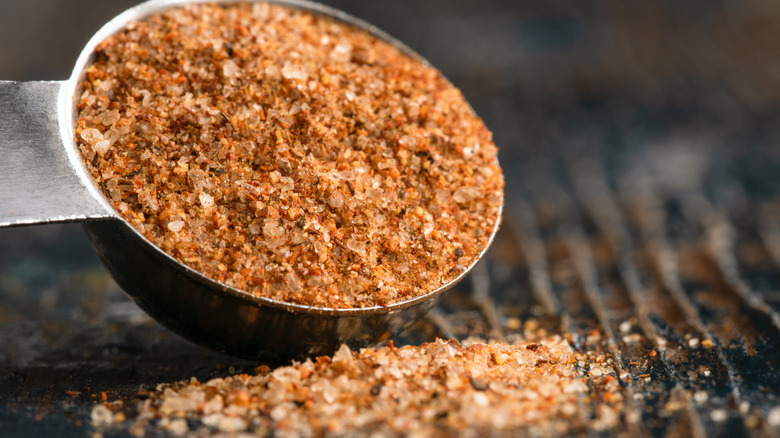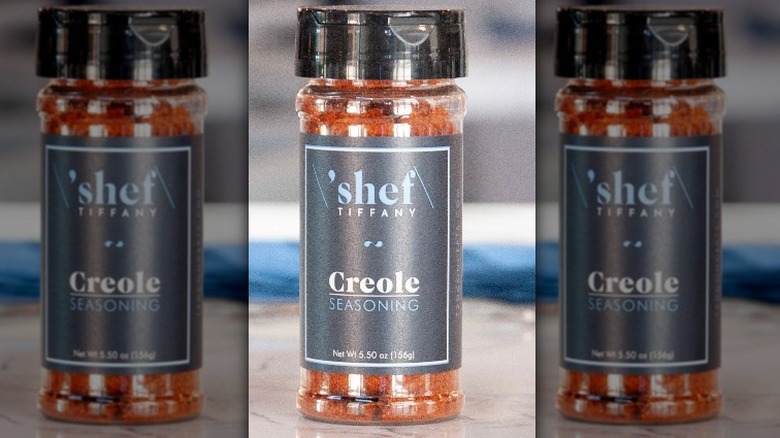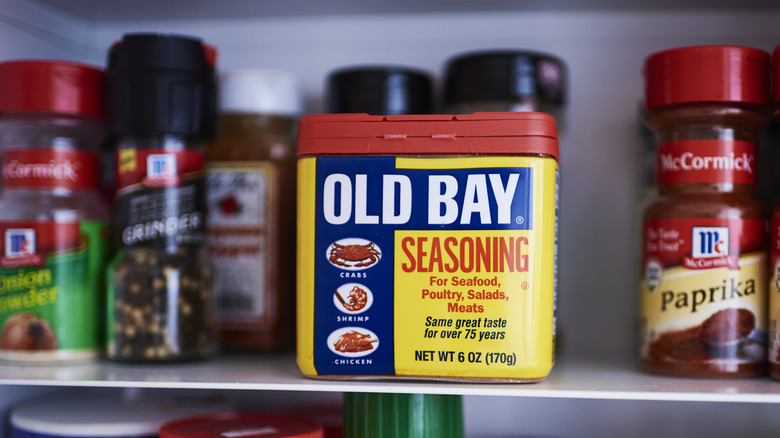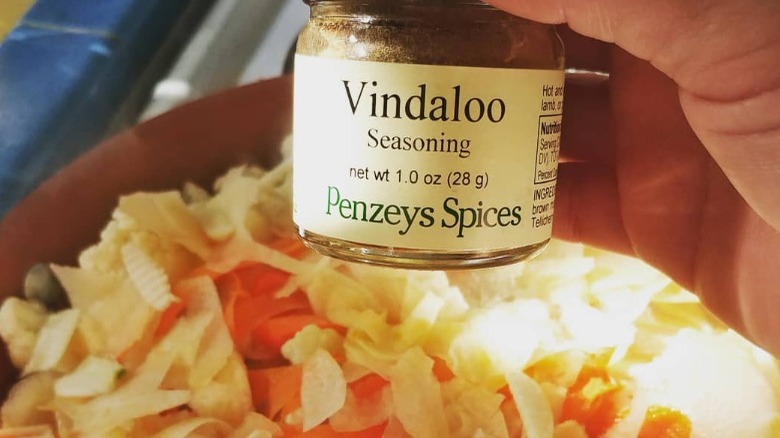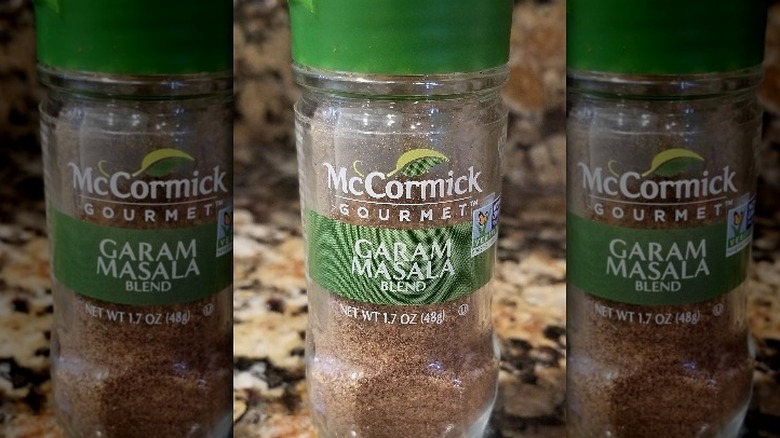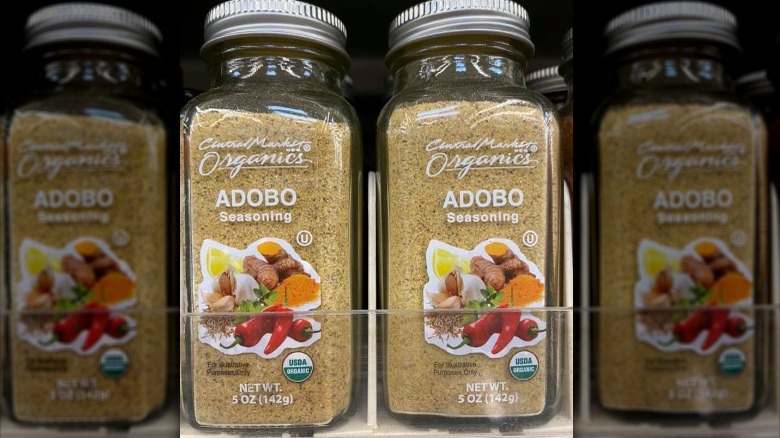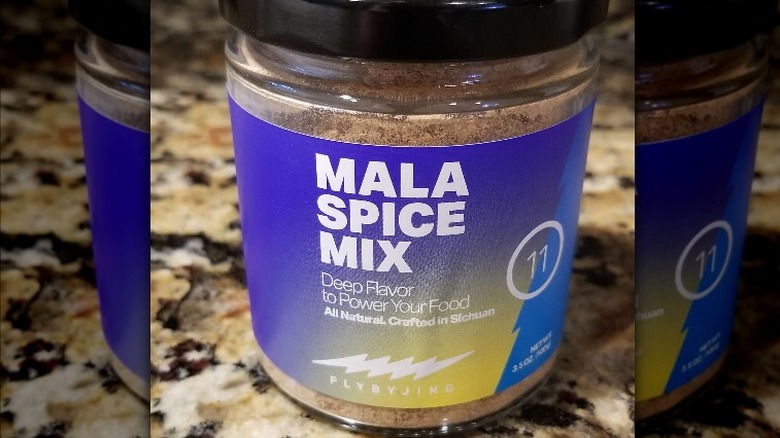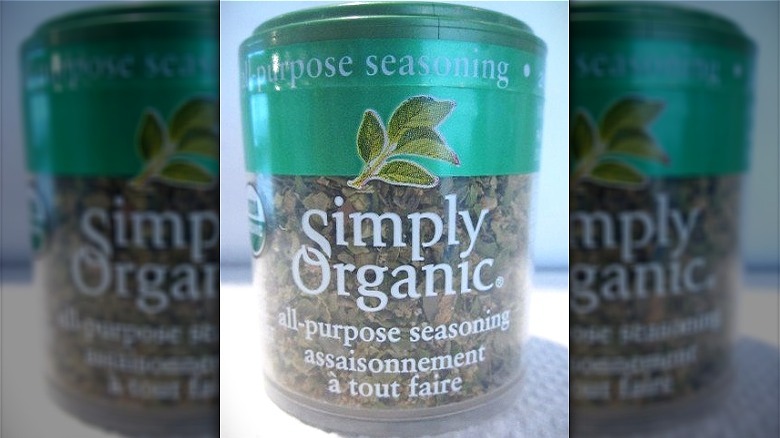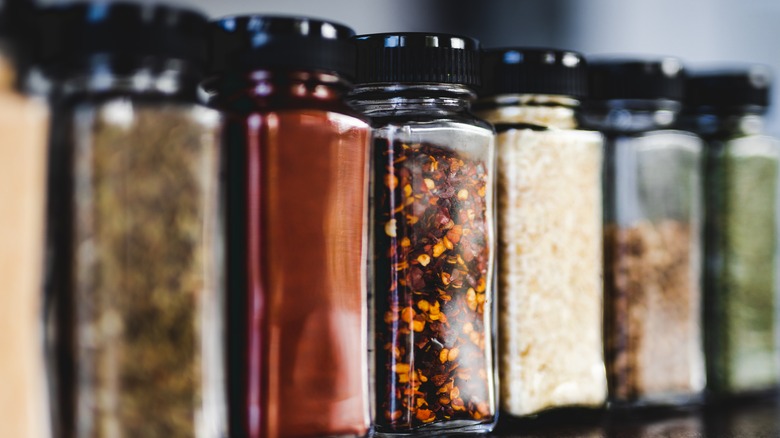The 7 Best Substitutes For Cajun Seasoning
Savory and spicy, Cajun seasoning adds a lively punch of flavor, transporting you to the southern dishes of Louisiana. The seasoning adds zesty flavor to crab cakes, blackened fish, roasted chicken, and seafood boil. The mix of spices is a staple ingredient in New Orleans favorites like gumbo, jambalaya, and étouffée.
Cajun cuisine was born out of the kitchens along the bayou, with influences from French, American Indian, Caribbean, and African cultures. The territory was declared a part of the French colonies in 1682, a gift for King Louis 14th of France, named Louisiana in his honor (via the Encyclopedia of French Cultural Heritage in North America). However, the Acadians didn't arrive in southern Louisiana until the mid-1700s, when the British deported them from their Northeastern Canadian homes after the French and Indian War. When these French Canadians arrived, they brought traditional French roots and flavors, marrying them with local influences. The combination became the beloved Cajun cuisine of today.
As the popularity of Cajun flavors spread throughout the country in the 1980s, and pre-made spice blends started to appear on store shelves, shares Spiceography. Though there is no set recipe for Cajun seasoning, it generally includes dried herbs and spices such as cayenne, paprika, pepper, garlic, and onion. The blend gives a mouthwatering kick to your morning scrambled eggs, or when dusted over popcorn. But, Acadiana's favorite spice isn't the only spice blend to enhance your favorite breakfast, lunch, or dinner fare. Consider one of these substitutes to add zesty richness, transporting you to the French Quarter.
Creole Seasoning
Creole and Cajun foods have similar roots, though Creole has more European influences. Louisiana's Creole people came directly from France, or other parts of the world, instead of Canada, shares New Orleans.com. Creole dishes are more refined and sophisticated than Cajun, born from the international flavors of Europe, the West Indies, and Africa.
For instance, the roots of gumbo came from African stews, with the name originating from the West African word for okra, ki ngombo, and mixed with French influence (via Pelican State of Mind). The roux-base of stew is similar to a French bouillabaisse. Creole flavors are sophisticated, using tomatoes and herbs in dishes, creating rich sauces. Cajun dishes are rustic, rural, and often prepared in one pot. Creole is the flavor of New Orleans; Cajun became the flavor of the Southern Louisiana countryside.
Creole and Cajun seasoning blends have similarities, including paprika, garlic, onion, and oregano. The significant difference between Creole and Cajun seasoning is that Creole generally does not include the heat of cayenne pepper, bringing a depth of flavor without the punch of spice. The more subtle of the two seasonings, Creole seasoning is interchangeable for use in Cajun cuisine, offers Spiceography. However, add a pinch of cayenne or red pepper flakes to mimic the heat Cajun seasoning gives dishes like jambalaya or alligator stew. Use Creole seasoning as a flavor enhancer after a dish is complete on vegetables, eggs, or pasta. Or, generously sprinkle on while cooking to blacken chicken or fish. Popular brands include Zatarain's and Tony Chachere's. We like "Shef from James Beard award nominee, Tiffany Derry.
Maryland Seafood Seasoning
No crab, shrimp, or crawfish seafood boil is complete without Maryland's favorite seafood seasoning blend, the signature spice of the Chesapeake Bay. The unconventional spice blend came from the fishing docks of Baltimore where fishermen were seasoning Maryland blue crab caught in the Bay, shares The Nosher.
Old Bay is the most common option available throughout the country, crafted over 75 years ago by Jewish German immigrant Gustav Brunn. He set up his Baltimore Spice Company across the street from the docks, blending a concoction of freshly ground cinnamon, cloves, bay leaf, paprika, and more. The fishermen loved it, as the blend gave smoky, earthy, savory flavors to sweet shellfish. Today spice giant McCormick owns the brand, opting to keep the mix of 18 ingredients in Old Bay proprietary. But, similar Maryland seafood blends include the identical ingredients found in Cajun seasoning, like onion, garlic, paprika, red pepper, and black pepper, along with clove, mustard seed, mace, cardamom, and bay leaves.
The wide range of spices adds deep, layered flavors to a dish, with more complexity than the heat-filled Cajun seasoning will give, per Pepper Scale. However, the similarities between the two can make Maryland seafood seasoning an acceptable exchange for Cajun seasoning. Old Bay does not have the heat of cayenne, so you may need to add a pinch of fiery spice to create an authentic piquant flavor. Sprinkle over all crustaceans, dash on white fish or cauliflower before grilling, or dust over French fries.
Vindaloo Spice Seasoning
Some Cajun seasonings include the signature Indian spice, turmeric, which is one of the most healthy spices in the world. Healthline notes the golden-hued root can reduce inflammation and help prevent heart disease, Alzheimer's, and cancer. India's vindaloo seasoning shares similar ingredients to Cajun seasoning. With Portuguese origins, vindaloo arrived in India when explorers brought a version to the country in the 1400s with their stew carne de vinha d'alhos, or meat marinated in wine vinegar and garlic (via Saveur). Once there, the dish began to incorporate local ingredients into the traditional spice and herb blend, adding warming brown spices to the mix. Today vindaloo is most often used in making a zesty curry. Sukhi writes that the spice blend includes cinnamon, cardamom, turmeric, and ginger, along with the classic Cajun flavors of garlic, onion, pepper, and spicy cayenne or chili peppers. Spicy chili peppers were brought to India by the Portuguese from the Americas.
Use the spice blend when preparing a dish, verses sprinkled on at the end. The late chef, Floyd Cardoz, known for crafting authentic Indian cuisine, shared the technique of toasting (or blooming) your spices to create your blend with Fine Cooking. He shares that gently toasting the spices in a hot pan will help release fragrant, floral, savory aromas and flavors. Vindaloo seasoning can be extremely peppery and spicy, depending on the strength of the chili peppers, so adding a bit of sugar can tame the heat, making it easier to enjoy the depth of flavor the spice mix gives to dishes.
Garam Masala
Like vindaloo, garam masala is one of India's favorite spice blends. The Ayurveda Experience shares masala is the Hindi word for spice, and garam, meaning hot. The spice blend is likely from regal homes of Northern India, where cold winter temperatures required food to have the ability to warm you from the inside. This also follows the eastern medicine concept of Ayurveda, where food and health combine. The thought behind the principle is that the combination of spices will increase your body's metabolism.
The blend typically does not contain chilis or cayenne pepper. Instead, the warmth of garam masala comes from up to 30 ingredients, creating a deeply complex flavor with refined subtlety, including ginger, giving aromatic freshness; cardamom, bringing minty, citrus notes; cumin, giving earthiness; cinnamon, providing sweetness. Combining the masala together delivers health benefits like lowering blood pressure, aiding digestion, and the total blend's ability to increase your metabolism. As the mixture does not have the fiery element of cayenne, garam masala gives an unexpected savory spin to dishes similar to Cajun seasoning without the punch of heat.
Traditionally, it is best to toast whole spices before being grinding them into a powder when preparing the combination, per Indian Kitchen and Spices. When the spices are fresh and fragrant you can easily add garam masala at the end of cooking as a finishing seasoning, as you would salt and pepper, keeping the perfumed aromas bright with a note of complexity at the forefront. Try it in your next batch of jambalaya or one of our étouffée recipes.
Adobo Seasoning
You have likely seen or cooked with chipotle peppers in adobo sauce; the small can sitting next to the salsa and hot sauce in the international food aisle. That little can packs a punch of smoky, pungent flavor thanks to the vinegary marinade of the adobo. Adobo seasoning is the Spanish and Filipino counterpart to Cajun seasoning. Adobo is from the Spanish word adobar, meaning marinade, and is much like vindaloo. Historically, adobo was a mix of spices with vinegar, used to preserve meat and pork.
The origin of adobo has been questioned over the years, per bon appetit. The name would lead us to believe it is of Spanish origin, likely from Southern Spain near the port city of Cadiz. But the Philippines also claim it as its national dish. Either way, when the Spanish began colonizing Latin America, the Caribbean, and the Philippines, adobo became a part of the cuisine, with each country developing its version, which is still present today.
Today, adobo sauce is most commonly used as a wet marinade for adobo chicken or pork in Filipino cooking, with the acidic sauce breaking down fatty meats and adding intense flavor. Puerto Rican and Mexican cuisine uses adobo as a dry rub for chicken and poultry, skirt steak, pork shoulder, and swordfish. With or without vinegar, the base of adobo is garlic, pepper, onion, salt, oregano, and turmeric. As adobo typically omits cayenne, be ready to add a pinch to bring the heat.
Mala Spice
We love the spiciness of Cajun seasoning. The punch of peppery fire from the cayenne makes your tongue tingle, your head swirl, and your toes curl. If you are like us and crave a pop of spice in everything you eat, swap your Cajun seasoning for mala spice. With origins in the Sichuan province of China, mala spice brings the heat and the flavor. And we do mean heat. In Chinese, ma means numbing, and la means spicy (via The Woks of Life). Mala produces a mind-numbing, mouthwatering flavor bomb, with complexity.
As hot peppers and warm spices are at the base of the blend, the seasoning creates a similar response in the body as garam masala or vindaloo, with the combination causing your body's temperature to rise, increasing your metabolism. Mala spice combines crushed, hot red chili peppers, floral, citrusy Sichuan peppercorns, and a variety of spices, including coriander, cumin, ginger, and star anise.
But mala isn't just a spicy, savory pepper blend. The seasoning often contains dried mushroom powder. This powder gives an underlying note of earthy umami, delivering a complex, satisfying combination of heat, sweet, bitter, salt, and umami, with uniquely Eastern spice flavors. Mixing mala spice with oil to use as a condiment or dipping sauce is most common, or sprinkling it on beef, poultry, or vegetables before grilling or roasting is most common. Use mala as the seasoning for your next crawfish boil or as a base for shrimp Creole.
Simply Organic All-Purpose Seasoning
If you're like us, you can dig into the back of your spice cabinet and find a jar of all-purpose seasoning. We usually buy a bottle along with poultry seasoning at Thanksgiving, use it to flavor our cornbread dressing, and then forget it is there. However, an all-purpose seasoning blend is one of the easiest ways to add a pop of savory umami to any dish. The seasoning is a blend of herbs and spices, including garlic, onion, pepper, and various dried herbs like parsley, basil, and oregano. It doesn't have the fiery heat of Cajun seasoning, as most all-purpose seasonings are sans red pepper or cayenne, but it brings the flavorful qualities of the blend.
We like Simply Organic All-Purpose Seasoning. It is salt-free and includes the typical spices found in Cajun seasoning without the heat of cayenne. Instead of heat, it adds loads of herbs. The seasoning includes dried basil, oregano, thyme, sage, parsley, and more, all grown organically. And, we like the brand, as Simply Organic is committed to helping those with food insecurity in North America. Through its Giving Fund Grant Program, the company donates to typically overlooked organizations, like produce farms helping refugees and immigrants, and food pantries helping feed inner-city kids. Any product that is good for the earth and good for our neighbors is a win-win for us.
If All Else Fails, Make Your Own
Making a homemade spice blend outweighs the use of a pre-packaged option any day, outside of the convenience factor of the sprinkle-and-go container. Creating your blend will allow you to use the freshest spices and herbs, giving you the opportunity to toast any spices prior to grinding, releasing the essential oils of the spices. And, you will be able to control the amount of salt included in the seasoning. A draw-back of most premade Cajun seasonings is that it includes salt — typically a lot of it. Brands like Slap Ya' Mama, Emeril's, and Rajun' Cajun can deliver your daily recommended sodium allotment with just a few shakes of the jar.
Masterclass shares that the blend should include onion powder, garlic powder, cayenne pepper, paprika, and pepper. If you only have a few of these ingredients, some are more effective than others in giving an authentic Cajun taste. Cayenne pepper (or some hot pepper like ground annatto seeds, dried chile de árbol, or crushed red pepper flakes) will bring the heat, smoky or sweet paprika (or a combination of both) will give smoke or sweetness, garlic powder and onion powder will add savory qualities. Mix each ingredient in a small bowl and sprinkle on. Or, even better, rim the glass of your morning Bloody Mary, and add a dash to your cocktail. Store any remaining seasoning in an air-tight container, and place it in a cool, dark cabinet to preserve the freshness.
